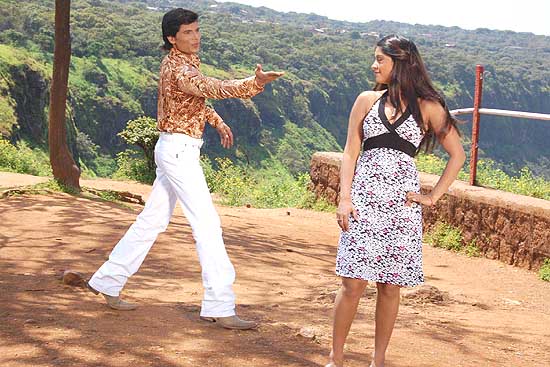|
28/08/2010
Bhojpuri cinema edges its way to success
By Arpana
New Delhi, Aug 28 (IANS) Under the big tree called Bollywood, the Bhojpuri film industry has been steadily taking root. While the mega Hindi film industry struggles to profit from its releases, its fledgling cousin has been growing steadily, doubling its output from 50 films four years ago to 100 films annually, and making money too.
 Industry insiders say films in the Hindi dialect can do even better if the government extends support. Industry insiders say films in the Hindi dialect can do even better if the government extends support.
"We now release about 100 films in a year. The average money spent yearly on Bhojpuri films is close to Rs.100 crore and the gross collection is about Rs.125 crore every year," Ranjan Sinha, spokesperson for the Bihar Jharkhand Motion Picture Association, told IANS on phone from Patna.
"Even if a film doesn't work, the producer doesn't have to bear a big loss. His loss is not more than Rs.10 lakh to 15 lakh."
The turning point, he said, came with the 2003 blockbuster "Sasura Bada Paisa Wala" with superstar Manoj Tiwari, sometimes compared to Rajnikanth.
The film was made at a budget of Rs.35 lakh to 40 lakh and made massive profits all over India.
"The film did a business of Rs.1.90 crore in Bihar, Rs.1.25 crore in Uttar Pradesh. Its all-India collections were Rs.4.5 crore," said Sinha.
The biggest consumer of Bhojpuri films are Bihar, Uttar Pradesh as well as Mumbai, which has sizeable migrant population from the Hindi belt. Bhojpuri films also get good audiences in West Bengal, Punjab and Gujarat, which are also home to migrants from Uttar Pradesh and Bihar.
"There are 372 cinema halls in Bihar and Jharkhand; of them, 180 run Bhojpuri films," said Sinha.
 "There are 32 centres in Mumbai where we run Bhojpuri films. After Bihar and Uttar Pradesh, Mumbai is the biggest market for Bhojpuri films. The major collection comes from Super Cinema at Grant Road and Navrang Theatre in Andheri - Bhojpuri films earn about Rs.300,000 to Rs.400,000 per week at these centres," added Shashikant Singh, a Mumbai-based film publicist. "There are 32 centres in Mumbai where we run Bhojpuri films. After Bihar and Uttar Pradesh, Mumbai is the biggest market for Bhojpuri films. The major collection comes from Super Cinema at Grant Road and Navrang Theatre in Andheri - Bhojpuri films earn about Rs.300,000 to Rs.400,000 per week at these centres," added Shashikant Singh, a Mumbai-based film publicist.
Costs are low. Most Bhojpuri films, costing about Rs.30 lakh to 45 lakh unless a big star like Tiwari is involved, are shot in small Bihar towns like Buxor and Gaya.
Bhojpuri heartthrob Tiwari charges somewhere between Rs.50 lakh and 60 lakh. Dinesh Lal Yadav Nirahua, Pawan Singh, Ravi Kishen and Vinay Anand round up the top five stars list.
Among the actresses, Rinku Ghosh and Mona Lisa are most sought after. Anara Gupta, Pakhi Hegde and Rani Chatterjee are the others in the top five list.
According to Tiwari, the picture would get rosier if the government steps in.
"It is indeed a growing industry, but our growth is slow. We could be five times better if the government supports us. Bhojpuri is not included in the Eighth Schedule of the constitution and so Bhojpuri films aren't bought by Doordarshan," he told IANS.
"As we are not listed in the Eighth Schedule, we are not eligible for National Awards also," he added.
"The sad part is that people from Bihar and Uttar Pradesh who represent us in parliament are not thinking about our culture," said Tiwari, who contested elections as a Samajwadi Party candidate for the Gorakhpur Lok Sabha seat and lost.
The future is bright but could be better if filmmakers spread the net wider to lure middle class audiences, instead of just targeting the front benchers.
"They should avoid using cheap words in the song and they should also try to come out with original scripts," said Sinha.
Manoj agreed: "Till now, the viewer for a Bhojpuri movie is from the lower strata of life. The middle classes don't come to see our films."
Manoj, whose "Mard No.1" will have an international release, feels that the government should try to release Bhojpuri films in multiplexes at subsidised rates to lure the affluent movie audience.
"Marathi films are being shown in Mumbai multiplexes at subsidised rates, something similar should be done for Bhojpuri films," said Manoj.
Bhojpuri cinema had an interesting beginning in the 1950s following an encounter between India's first Bihar-born president Rajendra Prasad and Mumbai-based character actor Nazir Hussain.
The president, upon realising that Hussain was a native of Ghazipur in eastern Uttar Pradesh, began to address him in his mother tongue Bhojpuri.
The conversation soon veered to movies and Rajendra Prasad asked Hussain, "Why don't you make a film in Bhojpuri?".
According to a book "Cinema Bhojpuri" by Avijit Ghosh, the encouragement from the president resulted in "Ganga Maiya Tobe Pyari Chadhaibo".
comments...
|

 Industry insiders say films in the Hindi dialect can do even better if the government extends support.
Industry insiders say films in the Hindi dialect can do even better if the government extends support.  "There are 32 centres in Mumbai where we run Bhojpuri films. After Bihar and Uttar Pradesh, Mumbai is the biggest market for Bhojpuri films. The major collection comes from Super Cinema at Grant Road and Navrang Theatre in Andheri - Bhojpuri films earn about Rs.300,000 to Rs.400,000 per week at these centres," added Shashikant Singh, a Mumbai-based film publicist.
"There are 32 centres in Mumbai where we run Bhojpuri films. After Bihar and Uttar Pradesh, Mumbai is the biggest market for Bhojpuri films. The major collection comes from Super Cinema at Grant Road and Navrang Theatre in Andheri - Bhojpuri films earn about Rs.300,000 to Rs.400,000 per week at these centres," added Shashikant Singh, a Mumbai-based film publicist. 